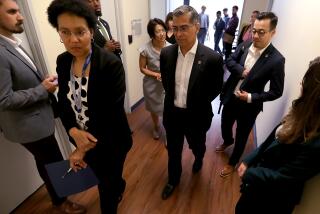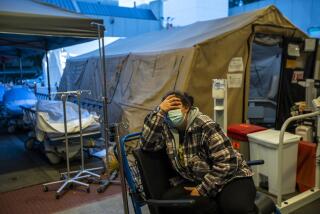Few Resources Are Available for Massive Disaster
- Share via
When two postal workers fearing they had been exposed to anthrax presented themselves at the most sophisticated trauma center in Los Angeles two weeks ago, the hospital had no system in place to segregate or decontaminate them.
Today, County-USC Medical Center has a brand-new decontamination area: a single portable shower set up on a loading dock, with an unassembled mass shower in storage nearby.
For the record:
12:00 a.m. Nov. 24, 2001 FOR THE RECORD
Los Angeles Times Saturday November 24, 2001 Home Edition Part A Part A Page 2 A2 Desk 2 inches; 48 words Type of Material: Correction
Disease list--A story Monday reported that only three of several diseases that might be spread by bioterrorists must be immediately reported to state public health authorities. On Nov. 5, however, temporary new regulations adding four new pathogens to the list took effect. The addition may become permanent after a public hearing in January.
At Northridge Hospital Medical Center, one of two trauma centers in the San Fernando Valley, doctors must rely on county-owned portable showers, used by hazardous materials cleanup teams, that collect contaminated water in children’s wading pools.
“You know those little round pools with pictures of fish on them? That’s what they use to collect the water in case it’s contaminated,” said Dr. Stephen Jones, medical director of emergency services for the hospital.
Such makeshift responses are par for the course after years of budget cuts that have left hospitals with too few beds and limited resources for handling a fast-moving calamity.
There are just 4,700 emergency rooms and 37,500 general intensive care beds in the United States--capacity that most public health experts say is woefully inadequate to handle a massive disaster.
The systems meant to track infectious disease--vital for spotting and fighting biological attacks--are so antiquated and disorganized that an estimated 80% of cases of some diseases go unreported, according to state and federal statistics. In California, the laws on reporting infectious disease are so outdated that only three of the pathogens that terrorists are considered likely to use must be immediately reported to public health authorities.
And neither the private sector, which dominates care in this country, nor the public sector, which has been radically cut back over the last 20 years, has the resources to fully prepare for a biological assault.
“The excess capacity has been slowly drained from the system,” said Dr. Mark Smith, chairman of emergency medicine at Washington Hospital Center in the nation’s capital. The hospital treated burn victims from the Sept. 11 assault on the Pentagon as well as patients feared to have been exposed to anthrax.
“The trick is to try to organize your resources so that you’re able to handle many more patients than you can handle ordinarily,” Smith said.
More Beds, Doctors Could Be Accessed
Dr. Mark Bell, associate medical director of the emergency department at Encino-Tarzana Medical Center, said he could stretch his 10-bed emergency room to accommodate dozens of people if needed. He said 60 doctors have promised to aid the two he normally has on staff.
“If we needed to, we could have patients who were less critical in hallways and gurneys and chairs,” Bell said. “And when we ran out of medications, we would ask for more.”
But it would be better, he said, if the hospital didn’t have to operate so close to the line.
“I’d love to have a hospital that was always 130% to 140% staffed,” said Bell, whose facility is owned by for-profit Tenet Corp. “In the best of all worlds there would be several free beds and several free nurses and several available units at every hospital citywide.”
Even the best-organized hospitals face serious challenges.
Parkland Hospital in Dallas, arguably one of the best-prepared in the nation, has physicians in every specialty ready to help people hurt or sickened in a terrorist attack, from trauma doctors to teams trained in administering dialysis to infectious disease squads.
There are decontamination areas in which to wash people exposed to chemical weapons, and sealed wings for patients with contagious diseases. Alternative routes are mapped out so doctors, nurses and paramedics can reach the hospital if the main roads are blocked.
Parkland even has seven doctors who specialize in pre-emergency care--the work that must be done out on the streets to examine patients and make sure that those who need hospital care are stable enough to transport.
But the hospital, for all its planning, can only handle 100 critically injured patients at a time, said Dr. Paul Pepe, head of emergency services for Parkland and chairman of emergency medicine at the University of Texas Southwestern Medical School, which runs the hospital. A hundred more can be handled at the region’s two lower-level trauma centers.
“If [a disaster] were immediately in Dallas and we had 200 patients at the three trauma centers, we would be overwhelmed,” said Pepe, whose emergency room has 80 beds and serves as the major trauma center for north Texas.
So Pepe is operating on a key assumption in emergency medicine--that generally in a big disaster most people are killed immediately or injured slightly. Relatively few, according to the conventional wisdom in the field, are critically injured survivors, and by making a little extra room and coordinating with other hospitals, all of them can be taken care of.
Resources Were More Abundant 20 Years Ago
There was a time when the U.S. health system would not have been so easily overwhelmed by a large influx of patients. Until 20 years ago, there were too many hospital rooms--not too few--and most facilities kept fairly large stores of supplies and medicine on hand.
But a combination of government belt-tightening and the rise of for-profit medicine forced hundreds of hospitals to close and hundreds more to reduce capacity.
By 1999, there were 805,000 hospital beds in the United States, down 12% from a decade earlier. The number of intensive care unit beds had dropped by 17%.
If a terrorist attack were to overwhelm a regional response system, state and federal public health emergency plans would be enacted, and patients who could not be treated near the scene of their injuries or exposure would be transported to other cities and states.
But the system is likely to work well only if an attack or outbreak is isolated to one or two areas, and only if transportation is available to take patients from one city to another.
Flaws in the system were painfully apparent Sept. 11.
When terrorists crashed into the Pentagon, Washington Hospital Center had on hand very little of an expensive synthetic skin used to cover wounds, said Smith and others.
A local children’s hospital sent over a small amount, and a distributor in Michigan put some in a car and drove it to Washington. But with air traffic stopped after the disaster, it was two days before a La Jolla company that makes the product could charter a plane and get it to the District of Columbia, said Dr. Gail Naughton, president of Advanced Tissue Sciences Inc.
Even before Sept. 11, hospitals were scrambling for sufficient supplies of equipment and vaccines.
During flu season, hospitals throughout Southern California routinely run out of ventilators, which would be vital for victims of a bioterrorist attack using botulism, said Virginia Hastings, the chief of emergency services for Los Angeles County.
There is also a severe nationwide shortage of tetanus vaccine, which Jones of Northridge Hospital Medical Center said was required by more than 600 patients in the five days after the Northridge earthquake.
The national Centers for Disease Control and Prevention has not included tetanus in its disaster planning and is not stockpiling the vaccine, CDC spokeswoman April Bell said.
Hospital Association Says Billions Needed
The American Hospital Assn. estimates that it will cost $1.3 billion for hospitals to stock enough supplies to avoid future delivery problems. It will cost $11 billion, the association estimates, to outfit all hospitals with decontamination equipment, sanitary suits for workers and air-conditioning systems that prevent the spread of contagion.
For now, many emergency room doctors, long used to operating under difficult conditions, insist that they can make do.
At County-USC, where there are just 35 beds in the emergency room, doctors would put patients on gurneys in hallways and turn operating rooms normally used for delivering babies or performing heart surgery into emergency centers, said Dr. David Altman, the facility’s medical director.
Taking a page from the lessons learned in New York, where cell phones as well as land lines failed to work after the attack on the World Trade Center, the hospital has appropriated 75 walkie-talkies generally used by the housekeeping department for use as communications tools in a disaster, Altman said.
As is common throughout the state, Los Angeles County has a network in place of 81 cooperating hospitals whose aim is to join together to provide care in the event of a regional disaster.
But county hospitals routinely run out of space for emergency patients even when there is no looming disaster, many shifting more than half of the sick people who come to their doors to other locations.
“If it were a major explosion or New York City kind of event and we have 5,000 casualties, could our hospitals handle them immediately?” Hastings asked. “The answer is no.”
More to Read
Sign up for Essential California
The most important California stories and recommendations in your inbox every morning.
You may occasionally receive promotional content from the Los Angeles Times.













